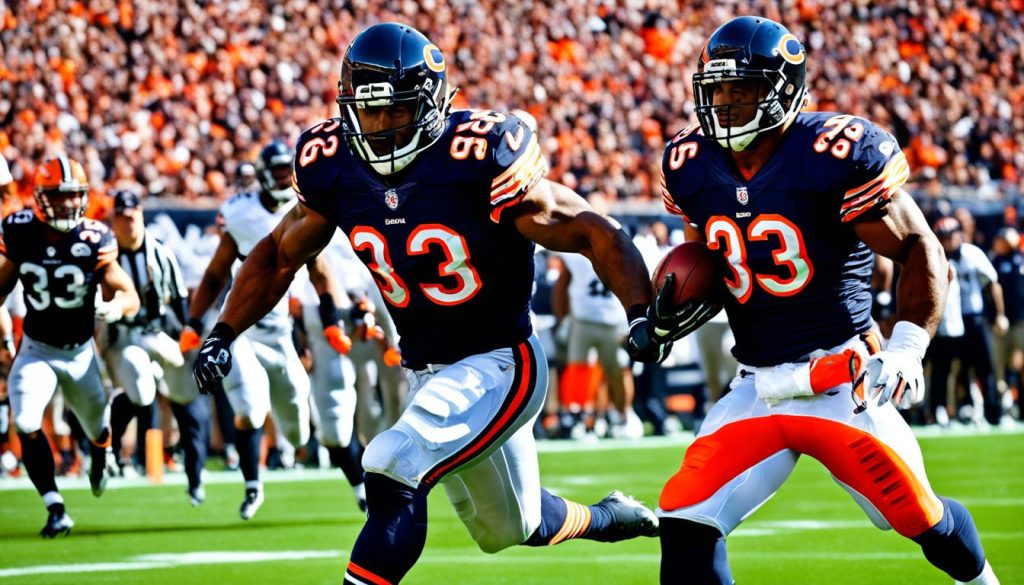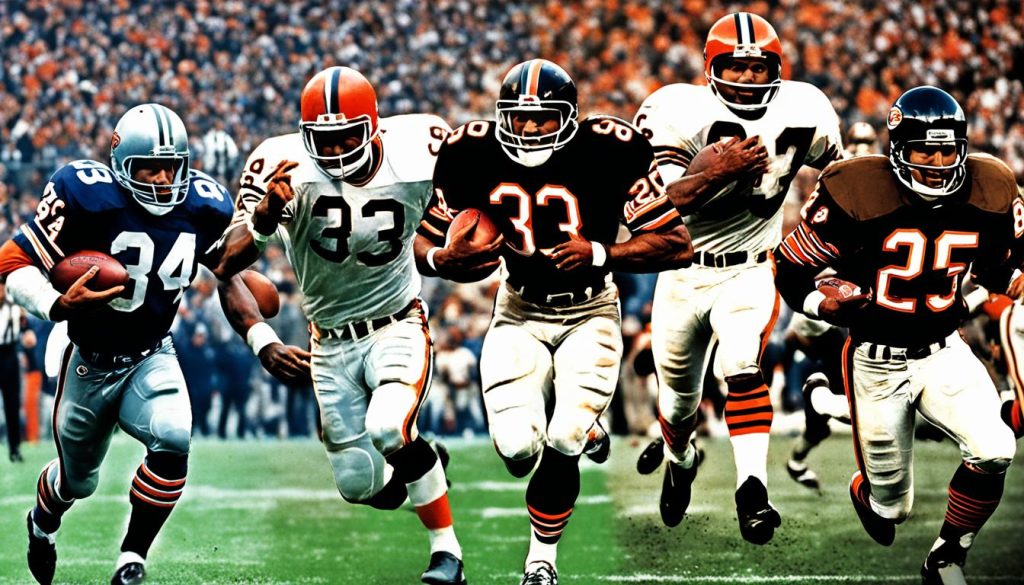Jim Brown vs. Walter Payton: Who Was the Greatest Running Back of All Time?
In the annals of NFL history, the debate surrounding the greatest running back to ever grace the gridiron ignites fervent discussion and passionate nostalgia. As you delve into the storied careers of Jim Brown and Walter Payton, prepare to traverse through a tale of two cities: the rugged playmaking of the Cleveland Browns’ powerhouse against the Chicago Bears’ embodiment of ‘Sweetness.’ These legends of the NFL, both impeccable Hall of Fame running backs, have set benchmarks that aspiring athletes still chase today. In this comparative analysis, we uncover what made these athletes not just remarkable runners but also quintessential icons of American football.
This exploration is more than a mere NFL legends comparison; it’s an ode to the golden era of football, a time when the ground game reigned supreme. Whether you’re a lifelong fan of the Bears vs Browns or new to the game, this narrative will captivate your imagination and provide insight into the sheer greatness that reverberates through the pages of sports history. Prepare to be immersed in a legacy of touchdowns, title games, and timeless memories shared by Brown and Payton, whose names are synonymous with the pinnacle of gridiron glory.
Key Takeaways
- Comparing two NFL titans, Jim Brown and Walter Payton, reveals a fascinating contrast in styles and careers.
- Jim Brown dominated the league with his unparalleled rushing average, while Walter Payton’s career longevity set him apart.
- Both players are celebrated as legends and for being the greatest NFL players, each leaving a lasting impact on the Browns and Bears respectively.
- The rich history and legacy of these Hall of Fame running backs continue to inspire and resonate with fans and players.
- The debate over the greatest running back enriches the NFL’s narrative and underscores the evolution of the game.
Jim Brown vs. Walter Payton: A Historical Showdown
As we set the stage for a clash between two titans of the gridiron, it is the echoes of their feats that resonate through the halls of NFL history. Jim Brown and Walter Payton, names that define an era of football excellence, continue to spark debates among fans and experts alike. Each represents a pinnacle of athletic prowess, embodying the essence of a historical football rivalry that transcends time.
The Legacy of Jim Brown
Jim Brown’s name is often the first that comes to mind when you ponder running back statistics. During his remarkable nine-season tenure, he amassed records that still stand as a testament to his dominance. With three MVP titles under his belt, and an impressive eight titles leading the NFL in rushing, his career achievements are monumental. Brown’s impact was felt not just in the statistics he generated but also in the rugged style of play he brought to each game. His legacy set the bar for generations to come, and his role in shaping the Cleveland Browns narrative cannot be overstated.
The Excellence of Walter Payton
Mention Walter Payton, and the term ‘Sweetness’ surfaces, reflecting the smooth, versatile athleticism that defined his 12-season career. His excellence echoed through the vibrant history of the Chicago Bears, culminating in a Super Bowl XX victory and an MVP award in 1977. Payton’s 16,726 career rushing yards placed him amongst the elite, and his characteristic endurance won him admiration and respect. His consistency and longevity are markers of his greatness, providing a parallel narrative to Brown’s prowess in the annals of NFL legends comparison.
Key Moments in Browns and Bears History
The careers of these NFL legends were not just about the accumulation of yards or the number of touchdowns; it was about the moments that became etched in history. For Jim Brown, it was each of the 118 games where he set a standard for rushing excellence, forever altering the Browns’ legacy. In Payton’s case, it was his significant contributions to the Bears’ 1985 championship team that cemented his status as an all-time great. These key moments are not simply historical footnotes; they are the substance of historical football rivalries that have shaped the NFL’s rich tapestry.
As the discussion unfolds, it’s clear that analyzing the traits and triumphs of Jim Brown and Walter Payton offers an inspiring narrative of sportsmanship and skill. Their drive and dedication on the field exemplified the spirit of competition and the relentless pursuit of glory. To better understand the magnitude of their impact on the game, one must delve into the definitive aspects of their careers, as presented in the following comparative statistics:
| Statistic | Jim Brown | Walter Payton |
|---|---|---|
| Career Rushing Yards | 12,312 | 16,726 |
| Rushing Touchdowns | 106 | 110 |
| MVP Titles | 3 | 1 |
| Seasons Leading NFL in Rushing | 8 | 1 |
| Pro Bowl Appearances | 9 | 9 |
The heralded accomplishments and riveting competitive spirit shared by both athletes continue to ignite the imagination of fans and players. As we reflect on their indelible impact, it is evident that Jim Brown and Walter Payton not only excel as individual legends but also exemplify the heart and soul of what makes the game of football an enduring American tradition.
Breaking Down the Stats: Career Rushing Yards and Touchdowns
If you’re delving into football player analysis, particularly comparing running backs from historic franchises like the Bears and Browns, the statistics not only narrate their impact but also reveal the essence of their legacies. As we analyze the running back statistics, it becomes evident how players like Walter Payton and Jim Brown have shaped the NFL legends comparison debate.
Walter Payton, the revered Chicago Bears icon, left an indelible mark with 16,726 career rushing yards, a monumental figure that, at the time, was eclipsed only by the great Emmitt Smith. Payton’s stats reflect not only his prowess but also his perseverance, as demonstrated by his 110 rushing touchdowns, ranking him fifth in the NFL’s all-time list. On the other side, representing the Cleveland Browns, Jim Brown’s statistical might is highlighted by his 106 rushing touchdowns, underscoring his enduring dominance in the league.
More than just numbers, each yard and touchdown contributed by these stalwarts of the gridiron tells a story. Jim Brown’s career average of an astounding 5.2 yards per carry is a testament to his power, and a benchmark many current NFL players aspire to reach. Meanwhile, Walter Payton’s extraordinary number of carries, standing at 3,838, not only speaks to his durability and resilience, but also his irreplaceable value to the Bears.
As we continue our exploration of these football titans, these stats are not simply figures in a record book; they provide in-depth insights into the hallmarks of NFL greats. Here is how their career stats stack up:
| Player | Career Rushing Yards | Rushing Touchdowns | Yards per Carry | NFL All-Time Rank |
|---|---|---|---|---|
| Walter Payton | 16,726 | 110 | N/A | 2nd (at retirement) |
| Jim Brown | 12,312 | 106 | 5.2 | 1st (at retirement) |
Your understanding of their prowess is enhanced through these statistics, granting a perspective that goes beyond mere fandom to appreciate the deeper influence they had within the Bears vs Browns rivalry and beyond. With every yard gained, touchdown scored, and defender outmaneuvered, these legends authored chapters of NFL history that remain unmatched.

The Impact Beyond Numbers: Career Achievements
Peering beyond the raw data, the legacy of two of the Greatest NFL players, Jim Brown and Walter Payton, is etched not just in their prolific career totals but in the lasting influence they’ve had on the world of professional football. Astounding career achievements and charitable contributions have set these legends apart as paragons of the game’s highest ideals.

Jim Brown’s MVP Titles and Rushing Titles
Jim Brown’s name is synonymous with superiority on the football field. His career achievements speak volumes, having claimed the coveted MVP title three times—a feat that cements his reputation among the Greatest NFL players. The sheer number of his rushing titles hearkens back to an era when his indomitable spirit dominated the league, leaving a legacy that both fans and historians revere.
Walter Payton’s Super Bowl XX Victory and MVP Award
For Walter Payton, triumph resonated beyond personal accolades, crystallizing in a team accomplishment—the Super Bowl XX victory. Payton’s illustrious career is highlighted by his 1977 MVP award, telling a story of dedication and consummate skill—a testament to his enduring legacy within the NFL’s annals.
Legacy and Charitable Contributions
Jim Brown and Walter Payton extended their impact beyond the field through notable charitable contributions. While Brown’s activism and philanthropy have made indelible marks, Payton’s distinction lives on through the Walter Payton NFL Man of the Year Award, an honor emphasizing community service and player excellence—factors crucial to the legacy comparison between these sporting icons.
NFL Legacies: Hall of Fame Inductions
When you reflect on the storied rivalries that have defined the NFL, none is more enduring than that of the Bears vs Browns, epitomized by the careers of Walter Payton and Jim Brown. These remarkable athletes not only smashed records on the gridiron but also soared to the pinnacle of their profession, forever immortalized as Hall of Fame running backs. As you trace the arcs of their careers, it becomes evident why they are often celebrated as two of the Greatest NFL players in the history of the sport.
Their meteoric rise and steadfast dedication culminated in the most prestigious acknowledgement: induction into the Pro Football Hall of Fame. Brown, whose legendary career concluded in the late 1960s, was immortalized in Canton, Ohio, in 1971. Two decades later, Payton joined this elite group, receiving his gold jacket in 1993. These moments stand as milestones, a legacy comparison that highlights not only their exceptional achievements but also the unyielding respect of their peers and the love of fans worldwide.
Induction into the Hall of Fame is a crowning glory that few athletes achieve, symbolizing not just personal accolades but also the indelible mark left on their teams—the Cleveland Browns and the Chicago Bears. Indeed, every touchdown, every strategic play, every game-winning rush contributed to the vibrant narrative of the Bears vs Browns history—a saga that resonates with sports enthusiasts across the nation.
From the stiff arm of Jim Brown to the powerhouse runs of Walter Payton, every move they made on the football field still echoes today. Their journeys from young, hopeful athletes to Hall of Fame running backs are comprised of thrilling highs and arduous challenges, each of which they navigated with inimitable grace and fortitude. As a testament to their impact, they are remembered not just as players but as legends—pillars in the pantheon of Greatest NFL players.
Part of understanding the grandiosity of their careers is acknowledging the different eras in which they played. It wasn’t merely about stats; it was about how they carried the ethos of the entire league on their shoulders. Their legacies, cast in bronze, hold a special place within the collective memory of the sport—a cherished narrative that inspires players and fans alike.
As we move forward through ever-evolving seasons of NFL play, the legacies of Payton and Brown continue to serve as the benchmark for excellence. They have set the standards that current players strive to meet and, perhaps, surpass. In the Hall of Fame, their stories will be told for generations to come, not just as remarkable athletes, but as the embodiment of the spirit and the heart of American football.
Strengths and Attributes: Football Player Analysis
As your football player analysis delves deeper into the unique attributes and strengths of Jim Brown and Walter Payton, you uncover the hallmarks that distinguished their careers. In examining their physicality, running back statistics, adaptability to playing conditions, and contributions to team success, the difference in their approach, versatility, and value to their teams becomes increasingly apparent.
Physicality and Running Style
Jim Brown’s imposing raw power and size were his trademarks, allowing him to offer a bruising style that bulldozed defenses and personified the tough ground game of his era. His ability to combine speed with strength set him apart as one of the most formidable running backs in NFL history, a sentiment supported by his prodigious running back statistics. In stark contrast, Walter Payton was noted for his exceptional agility and resilience. Payton’s style, a blend of finesse and raw power, often saw him eluding tackles with an uncanny ability to find daylight where none seemed to exist, making every carry a potential highlight.
Adaptability to Playing Conditions and Era
The ability to adapt to varying playing conditions and the demands of different eras is a testament to any player’s versatility. Payton’s flair was suited for the evolving NFL, where his all-rounded abilities shone brightly. Brown’s career, while grounded in an era heavy with rushing focus, was so dominant that it’s widely accepted he would have been just as successful in any subsequent football epoch. Their adaptability to playing conditions—whether it was a snow-covered field in Cleveland or the synthetic turf of Soldier Field—showcased their remarkable skills and resilience.
Contributions to Team Success and Leadership
The legacies of Jim Brown and Walter Payton are not solely forged through statistics and records; their contributions to team success and leadership were intrinsic to their careers. Both transcended their roles as running backs to become leaders—Brown with his athletic brilliance that motivated his Cleveland Browns teammates, and Payton with his unyielding determination and ethic that inspired the Chicago Bears. Their presence on and off the field boosted team morale and drive toward victory, proving that leadership can be as impactful as the most impressive running back statistics.
